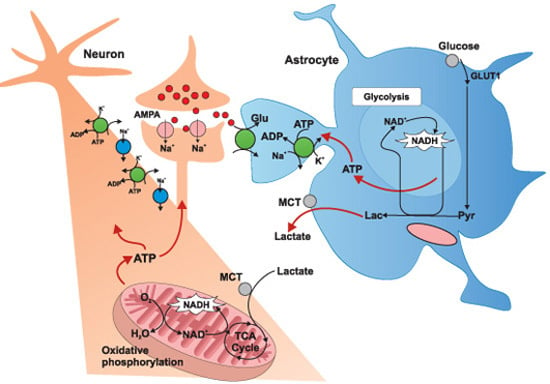Energy Metabolism of the Brain, Including the Cooperation between Astrocytes and Neurons, Especially in the Context of Glycogen Metabolism
Abstract
:1. Introduction
2. Location of Glycogen in the Brain and the Metabolic Compartments of the Brain
3. Regulatory Mechanisms for Glycogen Metabolism and Uptake of K+ in Astrocytes
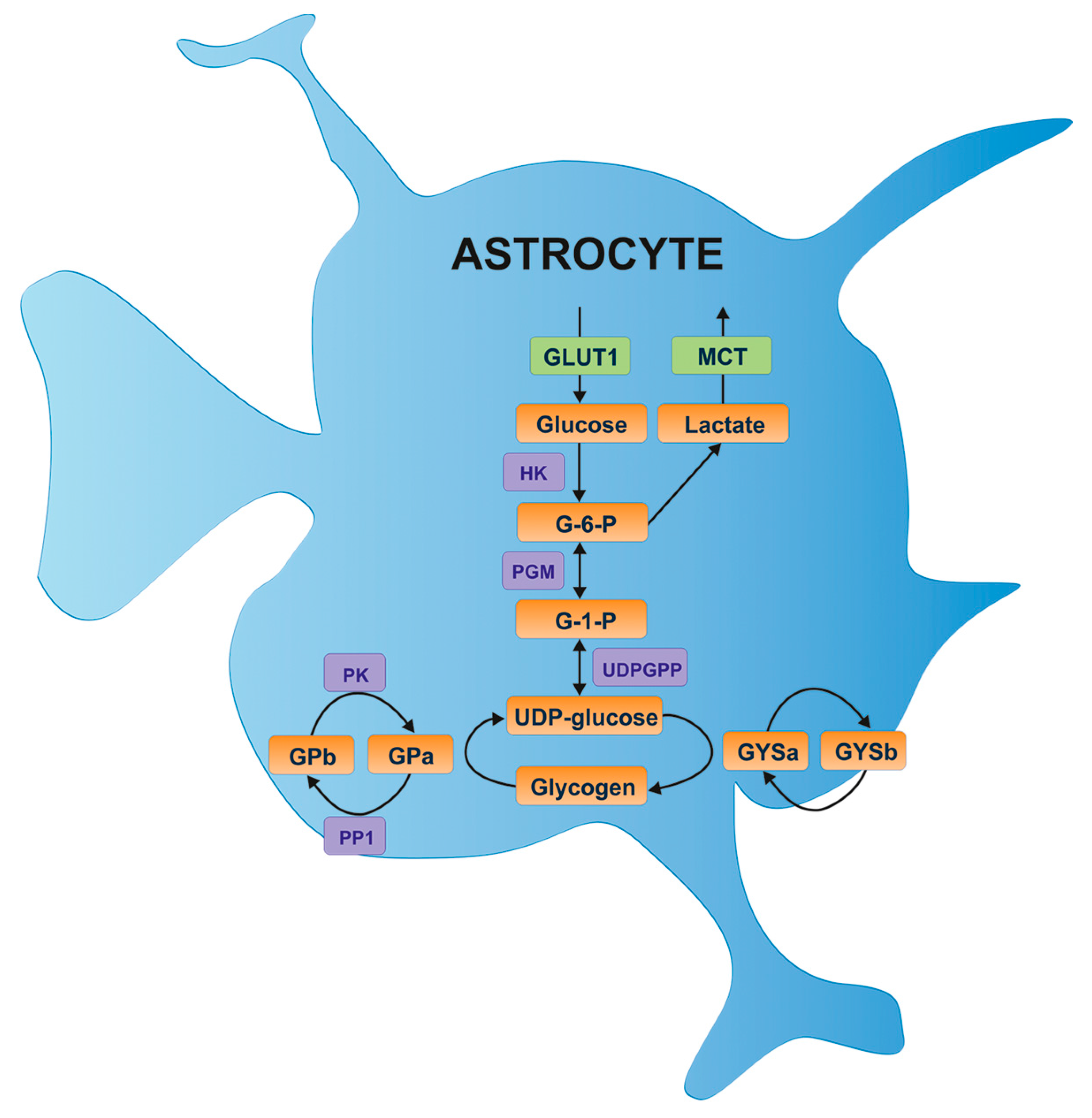
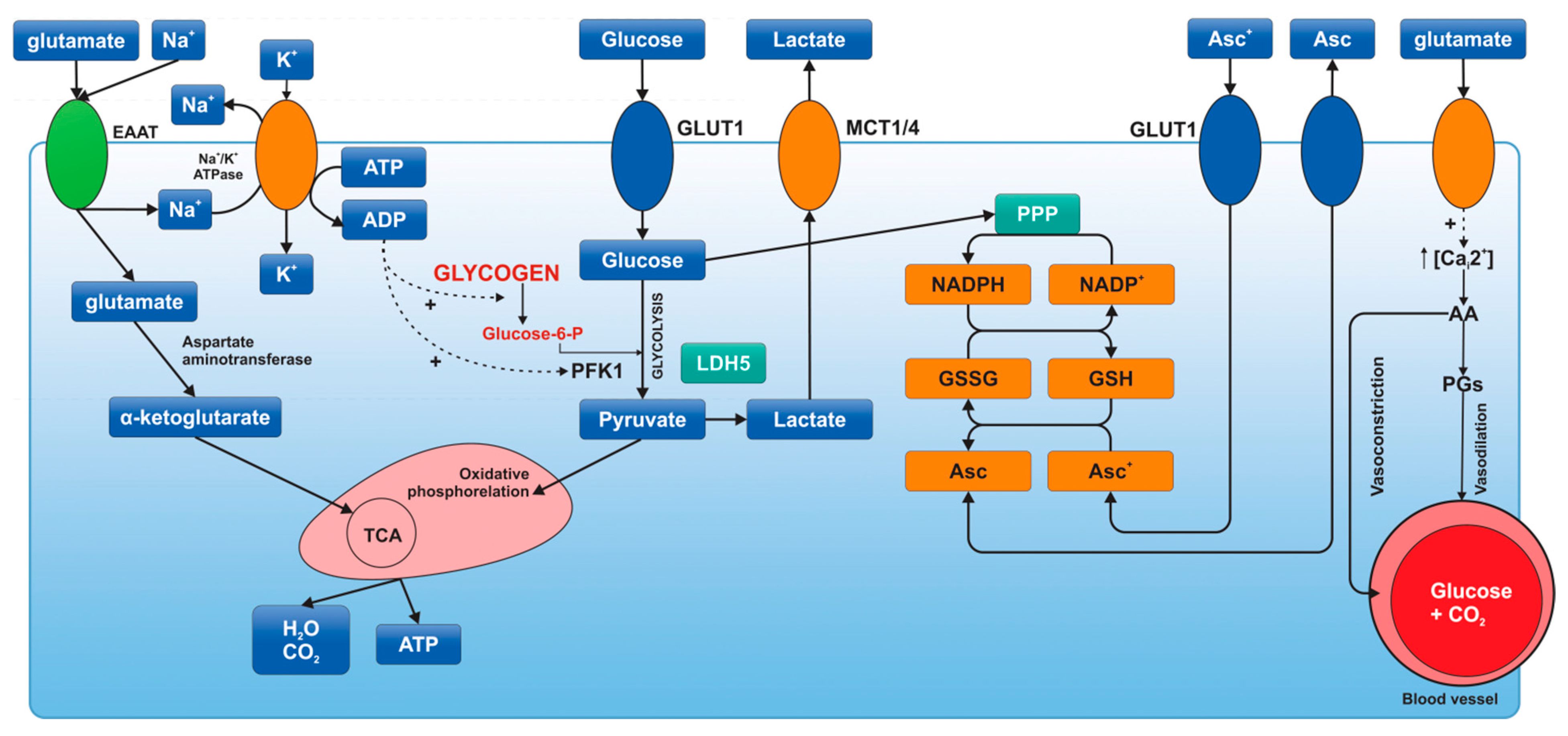
4. Lactate as a Major Metabolite. The Hypothesis of Lactate Transfer between Astrocyte and Neuron
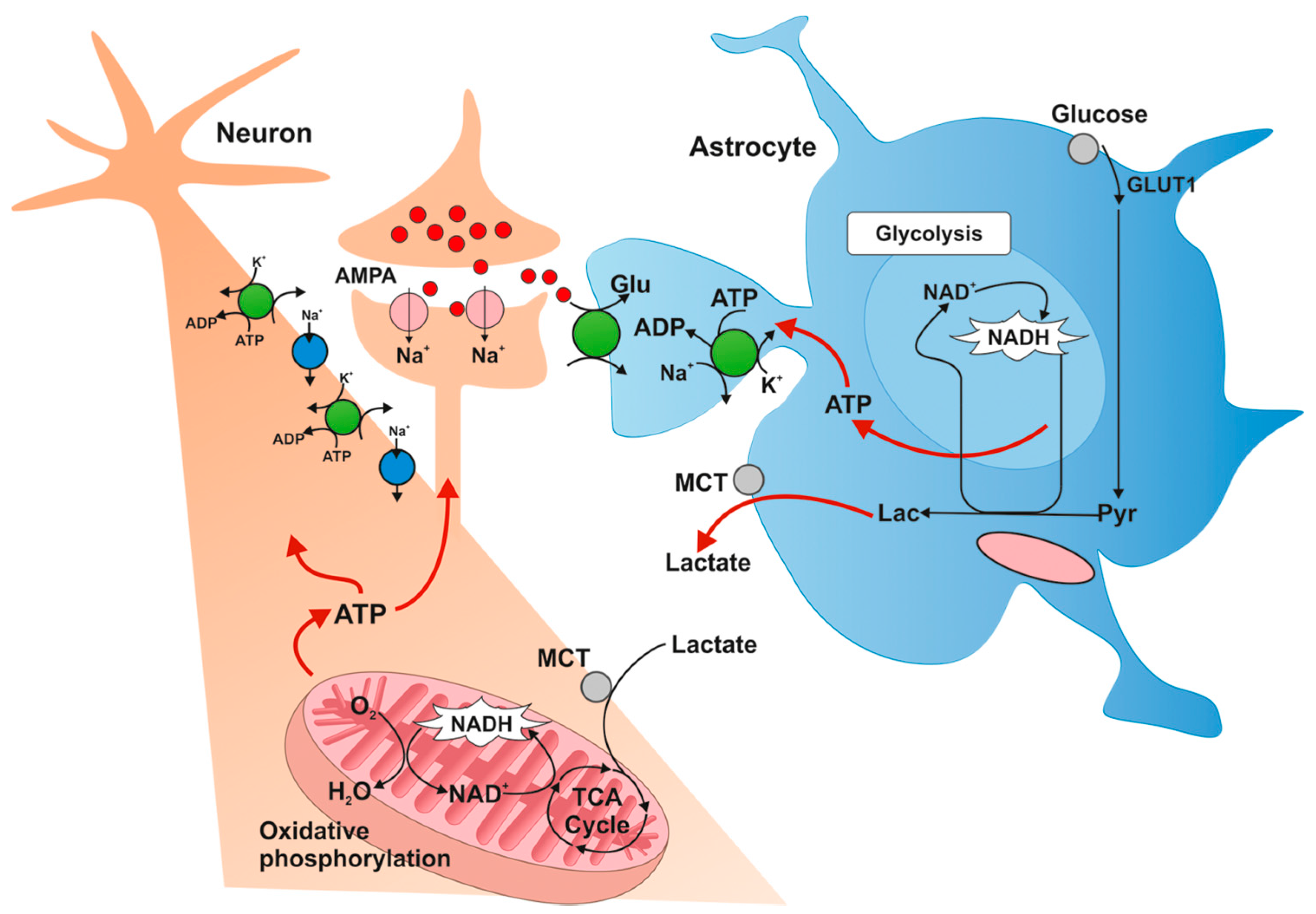
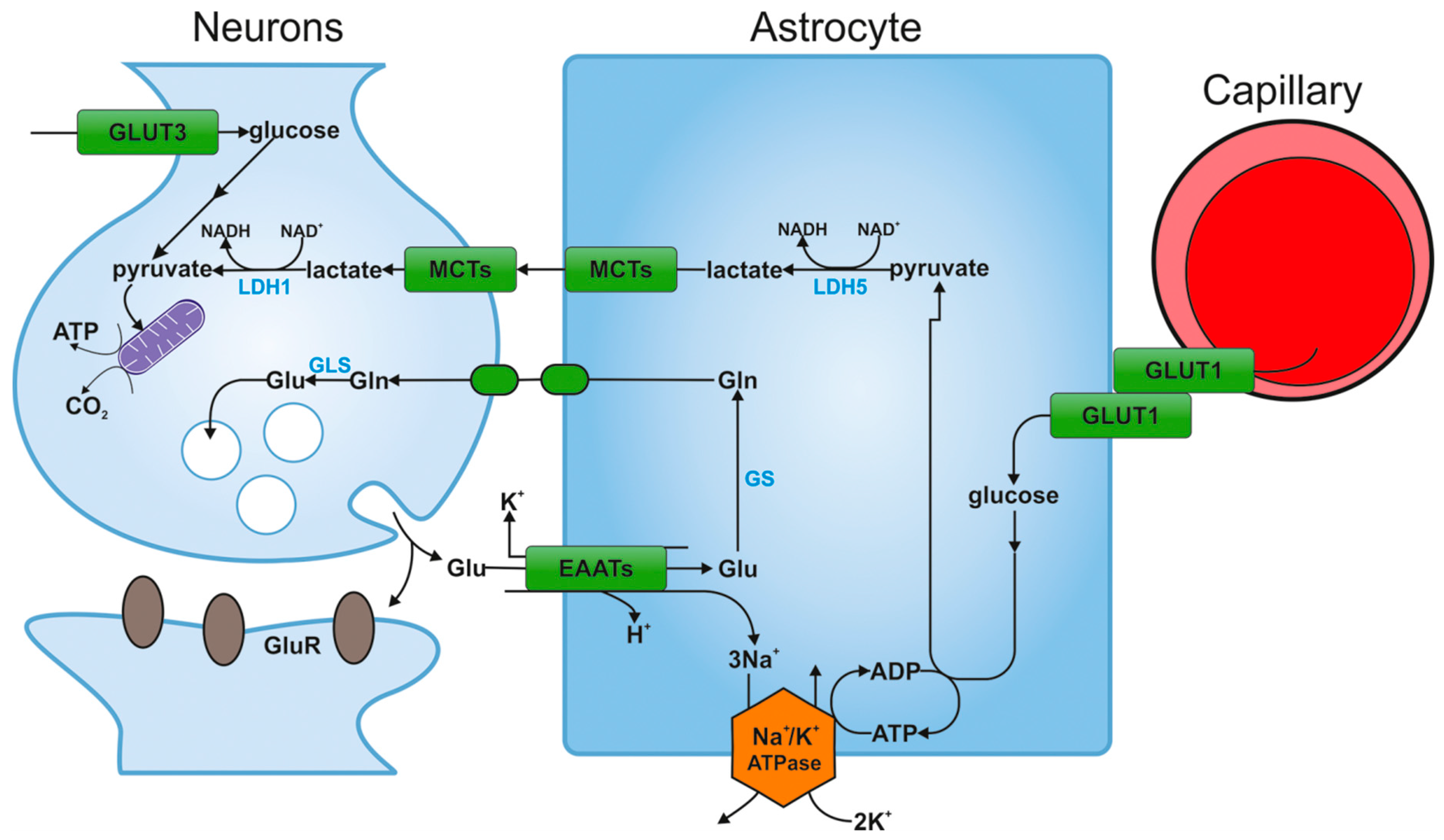
5. Glycolysis and Lactate Production Support Neuronal Activity
6. The Key Role of Astrocytes in Neurotransmission and the Importance of Brain Glycogen in Glutamatergic Transmission
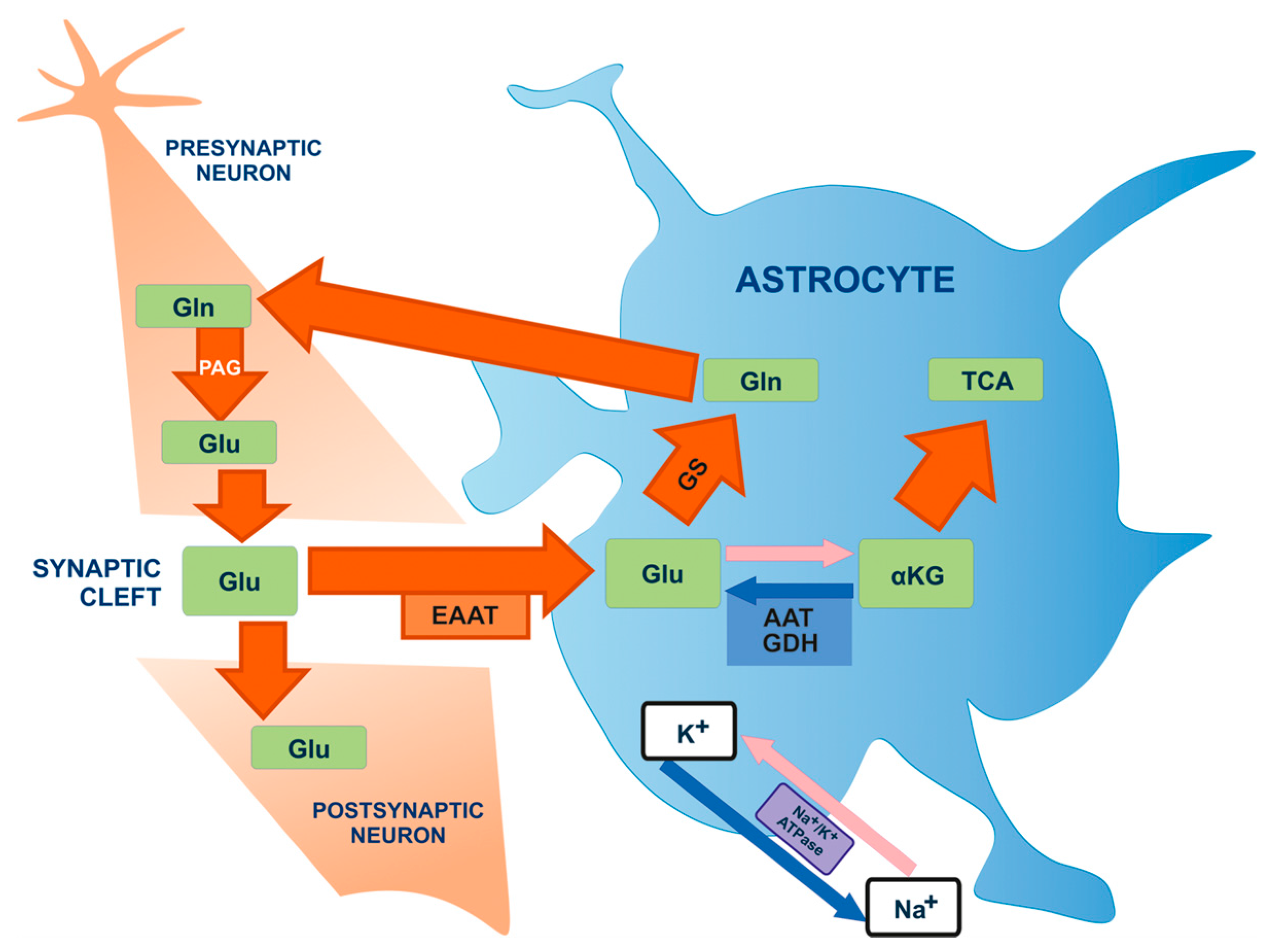
7. The Effect of Hypoglycemia on Brain Energy Metabolism
8. The Effect of Hypoglycemia on Cerebral Blood Flow (CBF)
9. The Role of Other Alternative Energy Substrates for the Brain
10. Diabetes and Energy Metabolism of the Brain—The Impact of Diabetes on Glycolysis, the TCA Cycle and the Metabolism of Glutamate
11. Diabetes and Hyperglycemia
12. Conclusions
Acknowledgments
Author Contributions
Conflicts of Interest
References
- Secher, N.H.; Quistorff, B. Brain glucose and lactate uptake during exhaustive exercise. J. Physiol. 2005, 568, 3. [Google Scholar] [CrossRef] [PubMed]
- Cataldo, A.M.; Broadwell, R.D. Cytochemical identification of cerebral glycogen and glucose-6-phosphatase activity under normal and experimental conditions. II. Choroid plexus and ependymal epithelia, endothelia and pericytes. J. Neurocytol. 1986, 15, 511–524. [Google Scholar] [CrossRef] [PubMed]
- Nehlig, A.; Pereira de Vasconcelos, A. Glucose and ketone body utilization by the brain of neonatal rats. Prog. Neurobiol. 1993, 40, 163–221. [Google Scholar] [CrossRef]
- Huang, Y.H.; Bergles, D.E. Glutamate transporters bring competition to the synapse. Curr. Opin. Neurobiol. 2004, 14, 346–352. [Google Scholar] [CrossRef] [PubMed]
- Matthias, K.; Kirchhoff, F.; Seifert, G.; Huttmann, K.; Matyash, M.; Kettenmann, H.; Steinhauser, C. Segregated expression of AMPA-type glutamate receptors and glutamate transporters defines distinct astrocyte populations in the mouse hippocampus. J. Neurosci. 2003, 23, 1750–1758. [Google Scholar] [PubMed]
- Pfeiffer-Guglielmi, B.; Fleckenstein, B.; Jung, G.; Hamprecht, B. Immunocytochemical localization of glycogen phosphorylase isozymes in rat nervous tissues by using isozyme-specific antibodies. J. Neurochem. 2003, 85, 73–81. [Google Scholar] [CrossRef] [PubMed]
- Magistretti, P.J.; Sorg, O.; Martin, J.L. Regulation of glycogen metabolism in astrocytes: Physiological, pharmacological, and pathological aspects. In Astrocytes: Pharmacology and Function; Murphy, S., Ed.; Academic Press: San Diego, CA, USA, 1993; pp. 243–265. [Google Scholar]
- Pellegri, G.; Rossier, C.; Magistretti, P.J.; Martin, J.L. Cloning, localization and induction of mouse brain glycogen synthase. Brain Res. Mol. Brain Res. 1996, 38, 191–199. [Google Scholar] [CrossRef]
- Sagar, S.M.; Sharp, F.R.; Swanson, R.A. The regional distribution of glycogen in rat brain fixed by microwave irradiation. Brain Res. 1987, 417, 172–174. [Google Scholar] [CrossRef]
- Kong, J.; Shepel, P.N.; Holden, C.P.; Mackiewicz, M.; Pack, A.I.; Geiger, J.D. Brain glycogen decreases with increased periods of wakefulness: Implications for homeostatic drive to sleep. J. Neurosci. 2002, 22, 5581–5587. [Google Scholar] [PubMed]
- Waagepetersen, H.S.; Hansen, G.H.; Fenger, K.; Lindsay, J.G.; Gibson, G.; Schousboe, A. Cellular mitochondrial heterogeneity in cultured astrocytes as demonstrated by immunogold labeling of α-ketoglutarate dehydrogenase. Glia 2006, 53, 225–231. [Google Scholar] [CrossRef] [PubMed]
- Vannucci, S.J.; Maher, F.; Simpson, I.A. Glucose transporter proteins in brain: Delivery of glucose to neurons and glia. Glia 1997, 21, 2–21. [Google Scholar] [CrossRef]
- Brown, A.M.; Ransom, B.R. Astrocyte glycogen and brain energy metabolism. Glia 2007, 55, 1263–1271. [Google Scholar] [CrossRef] [PubMed]
- Magistretti, P.J. Brain energy metabolism. In Fundamental Neuroscience, 3rd ed.; Squire, L.R., Berg, D., Bloom, F.E., du Lac, S., Ghosh, A., Spitzer, N.C., Eds.; Academic Press: San Diego, CA, USA, 2008; pp. 271–293. [Google Scholar]
- Nehlig, A. Brain uptake and metabolism of ketone bodies in animal models. Prostaglandins Leukot. Essent. Fat. Acids 2004, 70, 265–275. [Google Scholar] [CrossRef] [PubMed]
- Magistretti, P.J.; Sorg, O.; Yu, N.; Martin, J.L.; Pellerin, L. Neurotransmitters regulate energy metabolism in astrocytes: Implications for the metabolic trafficking between neural cells. Dev. Neurosci. 1993, 15, 306–312. [Google Scholar] [CrossRef] [PubMed]
- Hertz, L.; Peng, L.; Dienel, G.A. Energy metabolism in astrocytes: High rate of oxidative metabolism and spatiotemporal dependence on glycolysis/glycogenolysis. J. Cereb. Blood Flow Metab. 2007, 27, 219–249. [Google Scholar] [CrossRef] [PubMed]
- DiNuzzo, M.; Mangia, S.; Maraviglia, B.; Giove, F. Regulatory mechanisms for glycogenolysis and K+ uptake in brain astrocytes. Neurochem. Int. 2013, 63, 458–464. [Google Scholar] [CrossRef] [PubMed]
- Choi, H.B.; Gordon, G.R.; Zhou, N.; Tai, C.; Rungta, R.L.; Martinez, J.; Milner, T.A.; Ryu, J.K.; McLarnon, J.G.; Tresguerres, M.; et al. Metabolic communication between astrocytes and neurons via bicarbonate-responsive soluble adenylyl cyclase. Neuron 2012, 75, 1094–1104. [Google Scholar] [CrossRef] [PubMed]
- Xu, J.; Song, D.; Xue, Z.; Gu, L.; Hertz, L.; Peng, L. Requirement of glycogenolysis for uptake of increased extracellular K+ in astrocytes: Potential implications for K+ homeostasis and glycogen usage in brain. Neurochem. Res. 2013, 38, 472–485. [Google Scholar] [CrossRef] [PubMed]
- Subbarao, K.V.; Stolzenburg, J.U.; Hertz, L. Pharmacological characteristics of potassium-induced, glycogenolysis in astrocytes. Neurosci. Lett. 1995, 196, 45–48. [Google Scholar] [CrossRef]
- Brookes, N.; Turner, R.J. K+-induced alkalinization in mouse cerebral astrocytes mediated by reversal of electrogenic Na+-HCO3-cotransport. Am. J. Physiol. 1994, 267, C1633–C1640. [Google Scholar] [PubMed]
- Longnus, S.L.; Wambolt, R.B.; Parsons, H.L.; Brownsey, R.W.; Allard, M.F. 5-Aminoimidazole-4-carboxamide 1-β-d-ribofuranoside (AICAR) stimulates myocardial glycogenolysis by allosteric mechanisms. Am. J. Physiol. Regul. Integr. Comp. Physiol. 2003, 284, R936–R944. [Google Scholar] [CrossRef] [PubMed]
- Polekhina, G.; Gupta, A.; Michell, B.J.; van Denderen, B.; Murthy, S.; Feil, S.C.; Jennings, I.G.; Campbell, D.J.; Witters, L.A.; Parker, M.W.; et al. AMPK β subunit targets metabolic stress sensing to glycogen. Curr. Biol. 2003, 13, 867–871. [Google Scholar] [CrossRef]
- McBride, A.; Ghilagaber, S.; Nikolaev, A.; Hardie, D.G. The glycogen-binding domain on the AMPK β subunit allows the kinase to act as a glycogen sensor. Cell Metab. 2009, 9, 23–34. [Google Scholar] [CrossRef] [PubMed]
- DiNuzzo, M. Kinetic analysis of glycogen turnover: Relevance to human brain 13C-NMR spectroscopy. J. Cereb. Blood Flow Metab. 2013, 33, 1540–1548. [Google Scholar] [CrossRef] [PubMed]
- Crambert, G.; Hasler, U.; Beggah, A.T.; Yu, C.; Modyanov, N.N.; Horisberger, J.D.; Lelievre, L.; Geering, K. Transport and pharmacological properties of nine different human Na,K-ATPase isozymes. J. Biol. Chem. 2000, 275, 1976–1986. [Google Scholar] [CrossRef] [PubMed]
- Newman, E.A. Glial cell regulation of extracellular potassium. In Neuroglia; Kettenmann, H., Ransom, B.R., Eds.; Oxford University Press: New York, NY, USA, 1995; pp. 717–731. [Google Scholar]
- Munzer, J.S.; Daly, S.E.; Jewell-Motz, E.A.; Lingrel, J.B.; Blostein, R. Tissue- and isoform-specific kinetic behavior of the Na+, K+-ATPase. J. Biol. Chem. 1994, 269, 16668–16676. [Google Scholar] [PubMed]
- Brines, M.L.; Robbins, R.J. Cell-type specific expression of Na+, K+-ATPase catalytic subunits in cultured neurons and glia: Evidence for polarized distribution in neurons. Brain Res. 1993, 631, 1–11. [Google Scholar] [CrossRef]
- Shibayama, T.; Nakaya, K.; Nakamura, Y. Differential binding activity of erythrocyte ankyrin to the α-subunits of Na+, K+-ATPases from rat cerebral and axonal membrane. Cell Struct. Funct. 1993, 18, 79–85. [Google Scholar] [CrossRef] [PubMed]
- Yan, Y.; Dempsey, R.J.; Sun, D. Expression of Na+-K+-Cl− cotransporter in rat brain Turing development and its localization in mature astrocytes. Brain Res. 2001, 911, 43–55. [Google Scholar] [CrossRef]
- Ruminot, I.; Gutierrez, R.; Pena-Munzenmayer, G.; Anazco, C.; Sotelo-Hitschfeld, T.; Lerchundi, R.; Niemeyer, M.I.; Shull, G.E.; Barros, L.F. NBCe1 mediates the acute stimulation of astrocytic glycolysis by extracellular K+. J. Neurosci. 2001, 31, 14264–14271. [Google Scholar] [CrossRef] [PubMed]
- Svichar, N.; Esquenazi, S.; Waheed, A.; Sly, W.S.; Chesler, M. Functional demonstration of surface carbonic anhydrase IV activity on rat astrocytes. Glia 2006, 53, 241–247. [Google Scholar] [CrossRef] [PubMed]
- Fillenz, M. The role of lactate in brain metabolism. Neurochem. Int. 2005, 47, 413–417. [Google Scholar] [CrossRef] [PubMed]
- Herrero-Mendez, A.; Almeida, A.; Fernández, E.; Maestre, C.; Moncada, S.; Bolańos, J.P. The bioenergetic and antioxidant status of neurons is controlled by continuous degradation of a key glycolytic enzyme by APC/C-Cdh1. Nat. Cell Biol. 2009, 11, 747–752. [Google Scholar] [CrossRef] [PubMed]
- Castro, M.A.; Beltrán, F.A.; Brauchi, S.; Concha, I.I. A metabolic switch in brain: Glucose and lactate metabolism modulation by ascorbic acid. J. Neurochem. 2009, 110, 423–440. [Google Scholar] [CrossRef] [PubMed]
- Beltrán, F.A.; Acuńa, A.I.; Miró, M.P.; Angulo, C.; Concha, I.I.; Castro, M.A. Ascorbic acid-dependent GLUT3 inhibition is a critical step for switching neuronal metabolism. J. Cell Phys. 2001, 226, 3286–3294. [Google Scholar] [CrossRef] [PubMed]
- Castro, M.A.; Angulo, C.; Brauchi, S.; Nualart, F.; Concha, I.I. Ascorbic acid participates in a general mechanism for concerted glucose transport inhibition and lactate transport stimulation. Pflug. Arch. 2008, 457, 519–528. [Google Scholar] [CrossRef] [PubMed]
- Saez, I.; Duran, J.; Sinadinos, C.; Beltran, A.; Yanes, O.; Tevy, M.F.; Martínez-Pons, C.; Milán, M.; Guinovart, J.J. Neurons have an active glycogen metabolism that contributes to tolerance to hypoxia. J. Cereb. Blood Flow Metab. 2014, 34, 945–955. [Google Scholar] [CrossRef] [PubMed]
- Brooks, G.A. Cell-cell and intracellular lactate shuttles. J. Physiol. 2009, 587, 5591–5600. [Google Scholar] [CrossRef] [PubMed]
- Rothman, D.L.; Behar, K.L.; Hyder, F.; Shulman, R.G. In vivo NMR studies of the glutamate neurotransmitter flux and neuroenergetics: Implications for brain function. Annu. Rev. Physiol. 2003, 65, 401–427. [Google Scholar] [CrossRef] [PubMed]
- Hertz, L.; Dienel, G.A. Lactate transport and transporters: General principles and functional roles in brain cells. J. Neurosci. Res. 2005, 79, 11–18. [Google Scholar] [CrossRef] [PubMed]
- Pierre, K.; Pellerin, L. Monocarboxylate transporters in the central nervous system: Distribution, regulation and function. J. Neurochem. 2005, 94, 1–14. [Google Scholar] [CrossRef] [PubMed]
- Dalsgaard, M.K. Fuelling cerebral activity in exercising man. J. Cereb. Blood Flow Metab. 2006, 26, 731–750. [Google Scholar] [CrossRef] [PubMed]
- Becker, H.M.; Broer, S.; Deitmer, J.W. Facilitated lactate transport by MCT1 when coexpressed with the sodium bicarbonate cotransporter (NBC) in Xenopus oocytes. Biophys. J. 2004, 86, 235–247. [Google Scholar] [CrossRef]
- Juel, C. Current aspects of lactate exchange: Lactate/H+ transport in human skeletal muscle. Eur. J. Appl. Physiol. 2001, 86, 12–16. [Google Scholar] [CrossRef] [PubMed]
- Oldendorf, W.H.; Braun, L.; Cornford, E. pH dependence of blood-brain barrier permeability to lactate and nicotine. Stroke 1979, 10, 577–581. [Google Scholar] [CrossRef] [PubMed]
- Dalsgaard, M.K.; Secher, N.H. The brain at work: A cerebral metabolic manifestation of central fatigue? J. Neurosci. Res. 2007, 85, 3334–3339. [Google Scholar] [CrossRef] [PubMed]
- Dalsgaard, M.K.; Ide, K.; Cai, Y.; Quistorff, B.; Secher, N.H. The intent to exercise influences the cerebral O2/carbohydrate uptake ratio in humans. J. Physiol. 2002, 540, 681–689. [Google Scholar] [CrossRef] [PubMed]
- Ogoh, S.; Dalsgaard, M.K.; Yoshiga, C.C.; Dawson, E.A.; Keller, D.M.; Raven, P.B.; Secher, N.H. Dynamic cerebral autoregulation during exhaustive exercise in humans. Am. J. Physiol. Heart Circ. Physiol. 2005, 288, H1461–H1467. [Google Scholar] [CrossRef] [PubMed]
- Dalsgaard, M.K.; Ott, P.; Juul, A.; Warberg, J.; Dela, F.; Pedersen, B.K.; Fahrenkrug, J.; Secher, N.H. The CSF and arterial to internal jugular venous hormonal differences during exercise in humans. Exp. Physiol. 2004, 89, 271–277. [Google Scholar] [CrossRef] [PubMed]
- González-Alonso, J.; Dawson, E.A.; Secher, N.H.; Dalsgaard, M.K.; Ogoh, S.; Yoshiga, C.C.; Steensberg, A.; Raven, P.B. Standing up to the challenge of standing: A siphon does not support cerebral blood flow in humans. Am. J. Physiol. Regul. Integr. Comp. Physiol. 2004, 287, 911–914. [Google Scholar] [CrossRef]
- Ide, K.; Schmalbruch, I.K.; Quistorff, B.; Horn, A.; Secher, N.H. Lactate, glucose and O2 uptake in human brain during recovery from maximal exercise. J. Physiol. 2000, 522, 159–164. [Google Scholar] [CrossRef] [PubMed]
- Pellerin, L.; Bergersen, L.H.; Halestrap, A.P.; Pierre, K.J. Cellular and subcellular distribution of monocarboxylate transporters in cultured brain cells and in the adult brain. Neurosci. Res. 2005, 79, 55–64. [Google Scholar] [CrossRef] [PubMed]
- Hertz, L. The astrocyte-neuron lactate shuttle: A challenge of a challenge. J. Cereb. Blood Flow Metab. 2004, 24, 1241–1248. [Google Scholar] [CrossRef] [PubMed]
- Juel, C.; Halestrap, A.P. Lactate transport in skeletal muscle—Role and regulation of the monocarboxylate transporter. J. Physiol. 1999, 15, 633–642. [Google Scholar] [CrossRef]
- Tong, L.; Shen, H.; Perreau, V.M.; Balazs, R.; Cotman, C.W. Effects of exercise on gene-expression profile in the rat hippocampus. Neurobiol. Dis. 2001, 8, 1046–1056. [Google Scholar] [CrossRef] [PubMed]
- McCloskey, D.P.; Adamo, D.S.; Anderson, B.J. Exercise increases metabolic capacity in the motor cortex and striatum, but not in the hippocampus. Brain Res. 2001, 891, 168–175. [Google Scholar] [CrossRef]
- Kemppainen, J.; Aalto, S.; Fujimoto, T.; Kalliokoski, K.K.; Langsjo, J.; Oikonen, V.; Rinne, J.; Nuutila, P.; Knuuti, J. High intensity exercise decreases global brain glucose uptake in humans. J. Physiol. 2005, 568, 323–332. [Google Scholar] [CrossRef] [PubMed]
- Quistorff, B.; Secher, N.H.; van lieshout, J.J. Lactate fuels the human brain during exercise. FASEB J. 2008, 22, 3443–3449. [Google Scholar] [CrossRef] [PubMed]
- González-Alonso, J.; Dalsgaard, M.K.; Osada, T.; Volianitis, S.; Dawson, E.A.; Yoshiga, C.C.; Secher, N.H. Brain and central haemodynamics and oxygenation during maximal exercise in humans. J. Physiol. 2004, 15, 331–342. [Google Scholar] [CrossRef] [PubMed]
- Nybo, L.; Secher, N.H. Cerebral perturbations provoked by prolonged exercise. Prog. Neurobiol. 2004, 72, 223–261. [Google Scholar] [CrossRef] [PubMed]
- Swanson, R.A.; Yu, A.C.; Chan, P.H.; Sharp, F.R. Glutamate increases glycogen content and reduces glucose utilization in primary astrocyte culture. J. Neurochem. 1990, 54, 490–496. [Google Scholar] [CrossRef] [PubMed]
- Brown, A.M.; Tekkok, S.B.; Ransom, B.R. Glycogen regulation and functional role in mouse white matter. J. Physiol. 2003, 549, 501–512. [Google Scholar] [CrossRef] [PubMed]
- Ide, T.; Steinke, J.; Cahill, G.F. Metabolic interactions of glucose, lactate, and β-hydroxybutyrate in rat brain slices. Am. J. Physiol. 1969, 217, 784–792. [Google Scholar] [PubMed]
- Tabernero, A.; Vicario, C.; Medina, J.M. Lactate spares glucose as a metabolic fuel in neurons and astrocytes from primary culture. Neurosci. Res. 1996, 26, 369–376. [Google Scholar] [CrossRef]
- Cahill, G.F., Jr. Survival in starvation. Am. J. Clin. Nutr. 1998, 68, 1–2. [Google Scholar] [PubMed]
- Karmi, A.; Iozzo, P.; Viljanen, A.; Hirvonen, J.; Fielding, B.A.; Virtanen, K.; Oikonen, V.; Kemppainen, J.; Viljanen, T.; Guiducci, L.; et al. Increased brain fatty acid uptake in metabolic syndrome. Diabetes 2010, 59, 2171–2177. [Google Scholar] [CrossRef] [PubMed]
- Bouzier-Sore, A.K.; Voisin, P.; Canioni, P.; Magistretti, P.J.; Pellerin, L. Lactate is a preferential oxidative energy substrate overglucose for neurons in culture. J. Cereb. Blood Flow Metab. 2003, 23, 1298–1306. [Google Scholar] [CrossRef] [PubMed]
- Smith, D.; Pernet, A.; Hallett, W.A.; Bingham, E.; Marsden, P.K.; Amiel, S.A. Lactate: A preferred fuel for human brain metabolism in vivo. J. Cereb. Blood Flow Metab. 2003, 23, 658–664. [Google Scholar] [CrossRef] [PubMed]
- Dalsgaard, M.K.; Ogoh, S.; Dawson, E.A.; Yoshiga, C.C.; Quistorff, B.; Secher, N.H. Cerebral carbohydrate cost of physical exertion in humans. Am. J. Physiol. Regul. Integr. Comp. Physiol. 2004, 287, R534–R540. [Google Scholar] [CrossRef] [PubMed]
- Dalsgaard, M.K.; Nybo, L.; Cai, Y.; Secher, N.H. Cerebral metabolism is influenced by muscle ischaemia during exercise in humans. Exp. Physiol. 2003, 88, 297–302. [Google Scholar] [CrossRef] [PubMed]
- Suzuki, A.; Stern, S.A.; Bozdagi, O.; Huntley, G.W.; Walker, R.H.; Magistretti, P.J.; Alberini, C.M. Astrocyte-neuron lactate transport is required for long-term memory formation. Cell 2011, 144, 810–823. [Google Scholar] [CrossRef] [PubMed]
- Bak, L.K.; Schousboe, A.; Waagepetersen, H.S. The glutamate/GABA-glutamine cycle: Aspects of transport, neurotransmitter homeostasis and ammonia transfer. J. Neurochem. 2006, 98, 641–653. [Google Scholar] [CrossRef] [PubMed]
- McKenna, M.C. The glutamate-glutamine cycle is not stoichiometric: Fates of glutamate in brain. J. Neurosci. Res. 2007, 85, 3347–3358. [Google Scholar] [CrossRef] [PubMed]
- Stobart, J.L.; Anderson, C.M. Multifunctional role of astrocytes as gatekeepers of neuronal energy supply. Front. Cell. Neurosci. 2013, 7, 1–21. [Google Scholar] [CrossRef] [PubMed]
- Mozrzymas, J.; Szczęsny, T.; Rakus, D. The effect of glycogen phosphorolysis on basal glutaminergic transmission. Biochem. Biophys. Res. Commun. 2011, 404, 652–655. [Google Scholar] [CrossRef] [PubMed]
- Parpura, V.; Zorec, R. Gliotransmission: Exocytotic release from astrocytes. Brain Res. Rev. 2010, 63, 83–92. [Google Scholar] [CrossRef] [PubMed]
- Hertz, L.; Gibbs, M.E. What learning in day-old chickens can teach a neurochemist: Focus on astrocyte metabolism? J. Neurochem. 2009, 109, 10–16. [Google Scholar] [CrossRef] [PubMed]
- Sickmann, H.M.; Walls, A.B.; Schousbore, A.; Bouman, S.D.; Waagepetersen, H.S. Functional significance of brain glycogen in sustaining glutamatergic neurotransmission. J. Neurochem. 2009, 109, 80–86. [Google Scholar] [CrossRef] [PubMed]
- McCrimmon, R.J.; Sherwin, R.S. Hypoglycemia in type 1 diabetes. Diabetes 2010, 59, 2333–2339. [Google Scholar] [CrossRef] [PubMed]
- Choi, I.Y.; Seaquist, E.R.; Gruetter, R. Effect of hypoglycemia on brain glycogen metabolism in vivo. J. Neurosci. Res. 2003, 72, 25–32. [Google Scholar] [CrossRef] [PubMed]
- Oz, G.; Kumar, A.; Rao, J.P. Human brain glycogen metabolism during and after hypoglycemia. Diabetes 2009, 58, 1978–1985. [Google Scholar] [CrossRef] [PubMed]
- Dienel, G.A.; Ball, K.K.; Cruz, N.F. A glycogen phosphorylase inhibitor selectively enhances local rates of glucose utilization in brain during sensory stimulation of conscious rats: Implications for glycogen turnover. J. Neurochem. 2007, 102, 466–478. [Google Scholar] [CrossRef] [PubMed]
- Gruetter, R. Glycogen: The forgotten cerebral energy store. J. Neurosci. Res. 2003, 74, 179–183. [Google Scholar] [CrossRef] [PubMed]
- Brown, A.M.; Baltan Tekkok, S.; Ransom, B.R. Energy transfer from astrocytes to axons: The role of CNS glycogen. Neurochem. Int. 2004, 45, 529–536. [Google Scholar] [CrossRef] [PubMed]
- Cruz, N.F.; Dienel, G.A. High glycogen levels in brains of rats with minimal environmental stimuli: Implications for metabolic contributions of working astrocytes. J. Cereb. Blood Flow Metab. 2002, 22, 1476–1489. [Google Scholar] [CrossRef] [PubMed]
- Mason, G.F.; Rothman, D.L.; Behar, K.L.; Shulman, R.G. NMR determination of the TCA cycle rate and α-ketoglutarate/glutamate exchange rate in rat brain. J. Cereb. Blood Flow Metab. 1992, 12, 434–447. [Google Scholar] [CrossRef] [PubMed]
- Wender, R.; Brown, A.M.; Fern, R.; Swanson, R.A.; Farrell, K.; Ransom, B.R. Astrocytic glycogen influences axon function and survival during glucose deprivation in central white matter. J. Neurosci. 2000, 20, 6804–6810. [Google Scholar] [PubMed]
- Cryer, P.E. Mechanisms of hypoglycemia-associated autonomic failure and its component syndromes in diabetes. Diabetes 2005, 54, 3592–3601. [Google Scholar] [CrossRef] [PubMed]
- Sickmann, H.M.; Waagepetersen, H.S. Effects of diabetes on brain metabolism—Is brain glycogen a significant player? Metab. Brain Dis. 2015, 30, 335–343. [Google Scholar] [CrossRef] [PubMed]
- Abi-Saab, W.M.; Maggs, D.G.; Jones, T.; Jacob, R.; Srihari, V.; Thompson, J.; Kerr, D.; Leone, P.; Krystal, J.H.; Spencer, D.D.; et al. Striking differences in glucose and lactate levels between brain extracellular fluid and plasma in conscious human subjects: Effects of hyperglycemia and hypoglycemia. J. Cereb. Blood Flow Metab. 2002, 22, 271–279. [Google Scholar] [CrossRef] [PubMed]
- Jacob, R.J.; Fan, X.; Evans, M.L.; Dziura, J.; Sherwin, R.S. Brain glucose levels are elevated in chronically hyperglycemic diabetic rats: No evidence for protective adaptation by the blood brain barrier. Metabolism 2002, 51, 1522–1524. [Google Scholar] [CrossRef] [PubMed]
- Van Hall, G.; Strømstad, M.; Rasmussen, P.; Jans, O.; Zaar, M.; Gam, C.; Quistorff, B.; Secher, N.H.; Nielsen, H.B. Blood lactate is an important energy source for the human brain. J. Cereb. Blood Flow Metab. 2009, 29, 1121–1129. [Google Scholar] [CrossRef] [PubMed]
- Van Zijl, P.C.; Rothman, D. NMR studies of brain 13C-glucose uptake and metabolism: Present status. Magn. Reson. Imaging 1995, 13, 1213–1221. [Google Scholar] [CrossRef]
- Boumezbeur, F.; Petersen, K.F.; Cline, G.W.; Mason, G.F.; Behar, K.L.; Shulma, G.I.; Rothman, D.L. The contribution of blood lactate to brain energy metabolism in humans measured by dynamic 13C nuclear magnetic resonance spectroscopy. J. Neurosci. 2010, 30, 13983–13991. [Google Scholar] [CrossRef] [PubMed]
- Gallagher, C.N.; Carpenter, K.L.; Grice, P.; Howe, D.J.; Mason, A.; Timofeev, I.; Menon, D.K.; Kirkpatrick, P.J.; Pickard, J.D.; Sutherland, G.R.; et al. The human brain utilizes lactate via the tricarboxylic acid cycle: A 13C-labelled microdialysis and highresolution nuclear magnetic resonance study. Brain 2009, 132, 2839–2849. [Google Scholar] [CrossRef] [PubMed]
- Mason, G.F.; Petersen, K.F.; Lebon, V.; Rothman, D.L.; Shulman, G.I. Increased brain monocarboxylic acid transport and utilization in type 1 diabetes. Diabetes 2006, 55, 929–934. [Google Scholar] [CrossRef] [PubMed]
- Overgaard, M.; Rasmussen, P.; Bohm, A.M.; Seifert, T.; Brassard, P.; Zaar, M.; Homann, P.; Evans, K.A.; Nielsen, H.B.; Secher, N.H. Hypoxia and exercise provoke both lactate release and lactate oxidation by the human brain. FASEB J. 2012, 26, 3012–3020. [Google Scholar] [CrossRef] [PubMed]
- Pellerin, L.; Magistretti, P.J. Glutamate uptake stimulates Na+, K+-ATPase activity in astrocytes via activation of a distinct subunit highly sensitive to ouabain. J. Neurochem. 1997, 69, 2132–2137. [Google Scholar] [CrossRef] [PubMed]
- Wyss, M.T.; Jolivet, R.; Buck, A.; Magistretti, P.J.; Weber, B. In vivo evidence for lactate as a neuronal energy source. J. Neurosci. 2011, 31, 7477–7485. [Google Scholar] [CrossRef] [PubMed]
- Siesjo, B.K. Cell damage in the brain: A speculative synthesis. J.Cereb. Blood Flow Metab. 1981, 1, 155–185. [Google Scholar] [CrossRef] [PubMed]
- Pellerin, L.; Magistretti, P.J. Food for thought: Challenging the dogmas. J. Cereb. Blood Flow Metab. 2003, 23, 1282–1286. [Google Scholar] [CrossRef] [PubMed]
- Magistretti, P.J. Neuron-glia metabolic coupling and plasticity. J. Exp. Biol. 2006, 209, 2304–2311. [Google Scholar] [CrossRef] [PubMed]
- Lam, T.K.; Gutierrez-Juarez, R.; Pocai, A.; Rossetti, L. Regulation of blood glucose by hypothalamic pyruvate metabolism. Science 2005, 309, 943–947. [Google Scholar] [CrossRef] [PubMed]
- Shimizu, H.; Watanabe, E.; Hiyama, T.Y.; Nagakura, A.; Fujikawa, A.; Okado, H.; Yanagawa, Y.; Obata, K.; Noda, M. Glial Nax channels control lactate signaling to neurons for brain [Na+] sensing. Neuron 2007, 54, 59–72. [Google Scholar] [CrossRef] [PubMed]
- Erlichman, J.S.; Hewitt, A.; Damon, T.L.; Hart, M.; Kurascz, J.; Li, A.; Leiter, J.C. Inhibition of monocarboxylate transporter 2 in the retrotrapezoid nucleus in rats: A test of the astrocyte-neuron lactate-shuttle hypothesis. J. Neurosci. 2008, 28, 4888–4896. [Google Scholar] [CrossRef] [PubMed]
- Parsons, M.P.; Hirasawa, M. ATP-sensitive potassium channel-mediated lactate effect on orexin neurons: Implications for brain energetic during arousal. J. Neurosci. 2010, 30, 8061–8070. [Google Scholar] [CrossRef] [PubMed]
- Gavillet, M.; Allaman, I.; Magistretti, P.J. Modulation of astrocytic metabolic phenotype by proinflammatory cytokines. Glia 2008, 56, 975–989. [Google Scholar] [CrossRef] [PubMed]
- Bolaños, J.P.; Almeida, A.; Moncada, S. Glycolysis: A bioenergetic or a survival pathway? Trends Biochem. Sci. 2010, 35, 145–149. [Google Scholar] [CrossRef] [PubMed]
- Barros, L.F.; Deitmer, J.W. Glucose and lactate supply to the synapse. Brain Res. Rev. 2010, 63, 149–159. [Google Scholar] [CrossRef] [PubMed]
- Magistretti, P.J.; Pellerin, L.; Rothman, D.L.; Shulman, R.G. Energy on demand. Science 1999, 283, 496–497. [Google Scholar] [CrossRef] [PubMed]
- Bergersen, L.H. Is lactate food for neurons? Comparison of monocarboxylate transporter subtypes in brain and muscle. Neuroscience 2007, 145, 11–19. [Google Scholar] [CrossRef] [PubMed]
- Caesar, K.; Hashemi, P.; Douhou, A.; Bonvento, G.; Boutelle, M.G.; Walls, A.B.; Lauritzen, M. Glutamate receptor-dependent increments in lactate, glucose and oxygen metabolism evoked in rat cerebellum in vivo. J. Physiol. 2008, 586, 1337–1349. [Google Scholar] [CrossRef] [PubMed]
- Pierre, K.; Chatton, J.Y.; Parent, A.; Repond, C.; Gardoni, F.; di Luca, M.; Pellerin, L. Linking supply to demand: The neuronal monocarboxylate transporter MCT2 and the α-amino-3-hydroxyl-5-methyl-4-isoxazolepropionic acid receptor GluR2/3 subunit are ssociated in a common trafficking process. Eur. J. Neurosci. 2009, 29, 1951–1963. [Google Scholar] [CrossRef] [PubMed]
- Porras, O.H.; Loaiza, A.; Barros, L.F. Glutamate mediates acute glucose transport inhibition in hippocampal neurons. J. Neurosci. 2004, 24, 9669–9673. [Google Scholar] [CrossRef] [PubMed]
- Castro, M.A.; Pozo, M.; Cortés, C.; García Mde, L.; Concha, I.I.; Nualart, F. Intracellular ascorbic acid inhibits transport of glucose by neurons, but not by astrocytes. J. Neurochem. 2007, 102, 773–782. [Google Scholar] [CrossRef] [PubMed]
- Tudzarova, S.; Colombo, S.L.; Stoeber, K.; Carcamo, S.; Williams, G.H.; Moncada, S. Two ubiquitin ligases, APC/C-Cdh1 and SKP1-CUL1-F (SCF)-β-TrCP, sequentially regulate glycolysis during the cell cycle. Proc. Natl. Acad. Sci. USA 2011, 108, 5278–5283. [Google Scholar] [CrossRef] [PubMed]
- Chuquet, J.; Quilichini, P.; Nimchinsky, E.A.; Buzsáki, G. Predominant enhancement of glucose uptake in astrocytes versus neurons during activation of the somatosensory cortex. J. Neurosci. 2010, 30, 15298–15303. [Google Scholar] [CrossRef] [PubMed]
- Evans, R.D.; Brown, A.M.; Ransom, B.R. Glycogen function in adult central and peripheral nerves. J. Neurosci. Res. 2013, 91, 1044–1049. [Google Scholar] [CrossRef] [PubMed]
- Nelson, T.; Lucignani, G.; Atlas, S.; Crane, A.M.; Dienel, G.A.; Sokoloff, L. Reexamination of glucose-6-phosphatase activity in the brain in vivo: No evidence for a futile cycle. Science 1985, 229, 60–62. [Google Scholar] [CrossRef] [PubMed]
- Van de Ven, K.C.; de Galan, B.E.; van der Graaf, M.; Shestov, A.A.; Henry, P.G.; Tack, C.J.; Heerschap, A. Effect of acute hypoglycemia on human cerebral glucose metabolism measured by 13C magnetic resonance spectroscopy. Diabetes 2011, 60, 1467–1473. [Google Scholar] [CrossRef] [PubMed]
- Horinaka, N.; Artz, N.; Jehle, J.; Takahashi, S.; Kennedy, C.; Sokoloff, L. Examination of potential mechanisms in the enhancement of cerebral blood flow by hypoglycemia and pharmacological doses of deoxyglucose. J. Cereb. Blood Flow Metab. 1997, 17, 54–63. [Google Scholar] [CrossRef] [PubMed]
- Hernandez, M.J.; Vannucci, R.W.; Salcedo, A.; Brennan, R.W. Cerebral blood flow and metabolism during hypoglycemia in new born dogs. J. Neurochem. 1980, 35, 622–628. [Google Scholar] [CrossRef] [PubMed]
- Ghajar, J.B.G.; Plum, F.; Duffy, T.E. Cerebral oxidative metabolism and blood flow during acute hypoglycemia and recovery in unanesthetized rats. J. Neurochem. 1982, 38, 397–409. [Google Scholar] [CrossRef] [PubMed]
- Hollinger, B.R.; Bryan, R.M. J3-Receptor-mediated increase in cerebral blood during hypoglycemia. Am. J. Physiol. 1987, 253, H949–H955. [Google Scholar] [PubMed]
- Swafford, M.W.; Raty, S.; Childres, W.F.; Bryan, R.M., Jr. Effect of decreased glucose concentration on cerebrovascular tone in vitro. J. Cereb. Blood Flow Metab. 1998, 4, 391–395. [Google Scholar] [CrossRef] [PubMed]
- Ichord, R.N.; Helfaer, M.A.; Kirsch, J.R.; Wilson, D.; Traystman, R.J. Nitric oxide synthase inhibition attenuates hypoglycemic cerebral hyperemia in piglets. Am. J. Physiol. 1994, 266, H1062–H1068. [Google Scholar] [PubMed]
- Furchgott, R.F.; Zawadzki, J.V. The obligatory role of endothelial cells in the relaxation of arterial smooth muscle by acetylcholine. Nature 1980, 228, 373–376. [Google Scholar] [CrossRef]
- Palmer, R.M.J.; Ferrige, A.G.; Moncada, S. Nitric oxide release accounts for the biological activity of endothelium-derived relaxing factor. Nature 1987, 327, 524–526. [Google Scholar] [CrossRef] [PubMed]
- Ignarro, L.J. Biological action and properties of endothelium-derived nitric oxide formed and released from artery and vein. Circ. Res. 1989, 65, 1–21. [Google Scholar] [CrossRef] [PubMed]
- Sokoloff, L.; Kennedy, C.; Adachi, K.; Wang, F.; Takahashi, S.; Melzer, P. Effects of inhibitors of nitric oxide synthase on resting local cerebral blood flow and on the changes induced by hypercapnia or local functional activity. In Pharmacology of Cerebral Ischemia, 1st ed.; Kriegelstein, J., Oberpichler, H., Eds.; Wissenschaftliche Verlagsgesellschaft mbH: Stuttgart, Germany, 1992; pp. 371–382. [Google Scholar]
- Adachi, K.; Takahashi, S.; Melzer, P.; Campos, K.L.; Nelson, T.; Kennedy, C.; Sokoloff, L. Increases in local cerebral blood flow associated with somatosensory activation are not mediated by nitric oxide. Am. J. Physiol. 1994, 267, H2155–H2162. [Google Scholar] [PubMed]
- Greenberg, R.S.; Helfaer, M.A.; Kirsch, J.R.; Traystman, R.J. Effect of nitric oxide synthase inhibition on postischemic cerebral hyperemia. Am. J. Physiol. 1995, 269, H341–H347. [Google Scholar] [PubMed]
- Bryan, R.M.; Hollinger, B.R.; Keefer, K.A.; Rage, R.B. Regional cerebral and neural lobe blood flow during insulin-induced hypoglycemia in unanesthetized rats. J. Cereb. Blood Flow Metab. 1987, 7, 96–102. [Google Scholar] [CrossRef] [PubMed]
- Bryan, R.M., Jr.; Pelligrino, D.A. Cerebral blood flow during chronic hypoglycemia in the rat. Brain Res. 1988, 475, 397–400. [Google Scholar] [CrossRef]
- Suda, S.; Shinohara, M.; Miyaoka, M.; Lucignani, G.; Kennedy, C.; Sokoloff, L. The lumped constant of the deoxyglucose method in hypoglycemia: Effects of moderate hypoglycemia on local cerebral glucose utilization in the rat. J. Cereb. Blood Flow Metab. 1990, 10, 499–509. [Google Scholar] [CrossRef] [PubMed]
- Ghajar, J.B.; Gibson, G.E.; Duffy, T.E. Regional acetylcholine metabolism in brain during acute hypoglycemia and recovery. J. Neurochem. 1985, 44, 94–98. [Google Scholar] [CrossRef] [PubMed]
- Lewis, L.D.; Ljunggren, B.; Norberg, K.; Siesjo, B.K. Changes in carbohydrate substrates, amino acids and ammonia in the brain during insulin-induced hypoglycemia. J. Neurochem. 1974, 23, 659–671. [Google Scholar] [CrossRef] [PubMed]
- Pardridge, W.M. Transport of nutrients and hormones through the blood-brain barrier. Fed. Proc. 1984, 43, 201–204. [Google Scholar] [CrossRef] [PubMed]
- Choi, I.Y.; Lee, S.P.; Kim, S.G.; Gruetter, R. In vivo measurements of brain glucose transport using the reversible Michaelis-Menten model and simultaneous measurements of cerebral blood blow changes during hypoglycemia. J. Cereb. Blood Flow Metab. 2001, 21, 653–663. [Google Scholar] [CrossRef] [PubMed]
- Abdul-Rahman, A.; Agardh, C.D.; Siesjo, B.K. Local cerebral blood flow in the rat during severe hypoglycemia, and in the recovery period following glucose injection. Acta Physiol. Scand. 1980, 109, 307–314. [Google Scholar] [CrossRef] [PubMed]
- Bryan, R.M., Jr.; Eichler, M.Y.; Johnson, T.D.; Woodward, W.T.; Williams, J.L. Cerebral blood flow, plasma catecholamines, and electroencephalogram during hypoglycemia and recovery after glucose infusion. J. Neursurg. Anesthesiol. 1994, 6, 24–34. [Google Scholar] [CrossRef]
- Laffel, L. Ketone bodies: A review of physiology, pathophysiology and application of monitoring to diabetes. Diabetes Metab. Res. Rev. 1999, 15, 412–426. [Google Scholar] [CrossRef]
- Morris, A.A. Cerebral ketone body metabolism. J. Inherit. Metab. Dis. 2005, 28, 109–121. [Google Scholar] [CrossRef] [PubMed]
- Roberts, E.J. The support of energy metabolism in the central nervous system with substrates other than glucose. In Brain Energetics. Integration of Molecular and Cellular Processes, 3rd ed.; Dienel, G., Gibson, G., Eds.; Springer: Berlin, Germany; Heidelberg, Germany, 2007; pp. 197–238. [Google Scholar]
- Suh, S.W.; Aoyama, K.; Matsumori, Y.; Liu, J.; Swanson, R.A. Pyruvate administered after severe hypoglycemia reduces neuronal death and cognitive impairment. Diabetes 2005, 54, 1452–1458. [Google Scholar] [CrossRef] [PubMed]
- Biessels, G.J.; Gispen, W.H. The impact of diabetes on cognition: What can be learned from rodent models? Neurobiol. Aging 2005, 26, 36–41. [Google Scholar] [CrossRef] [PubMed]
- McNay, E.C.; Ong, C.T.; McCrimmon, R.J.; Cresswell, J.; Bogan, J.S.; Sherwin, R.S. Hippocampal memory processes are modulated by insulin and high-fat-induced insulin resistance. Neurobiol. Learn. Mem. 2010, 93, 546–553. [Google Scholar] [CrossRef] [PubMed]
- Baird, T.A.; Parsons, M.W.; Barber, P.A.; Butcher, K.S.; Desmond, P.M.; Tress, B.M.; Colman, P.G.; Jerums, G.; Chambers, B.R.; Davis, S.M. The influence of diabetes mellitus and hyperglycaemia on stroke incidence and outcome. J. Clin. Neurosci. 2002, 9, 618–626. [Google Scholar] [CrossRef] [PubMed]
- Reagan, L.P.; Rosell, D.R.; Alves, S.E.; Hoskin, E.K.; McCall, A.L.; Charron, M.J.; McEwen, B.S. GLUT8 glucose transporter is localized to excitatory and inhibitory neurons in the rat hippocampus. Brain Res. 2002, 932, 129–134. [Google Scholar] [CrossRef]
- Simpson, I.A.; Carruthers, A.; Vannucci, S.J. Supply and demand in cerebral energy metabolism: The role of nutrient transporters. J. Cereb. Blood Flow Metab. 2007, 27, 1766–1791. [Google Scholar] [CrossRef] [PubMed]
- Duarte, J.M.; Carvalho, R.A.; Cunha, R.A.; Gruetter, R. Caffeine consumption attenuates neurochemical modifications in the hippocampus of streptozotocin-induced diabetic rats. J. Neurochem. 2009, 111, 368–379. [Google Scholar] [CrossRef]
- Soltesova, D.; Vesela, A.; Mravec, B.; Herichova, I. Daily profile of glut1 and glut4 expression in tissues inside and outside the blood—Brain barrier in control and streptozotocin-treated rats. Physiol. Res. 2013, 62, S115–S124. [Google Scholar] [PubMed]
- Pardridge, W.M.; Triguero, D.; Farrell, C.R. Downregulation of bloodbrain barrier glucose transporter in experimental diabetes. Diabetes 1990, 39, 1040–1044. [Google Scholar] [CrossRef] [PubMed]
- Garcia-Espinosa, M.A.; Garcia-Martin, M.L.; Cerdan, S. Role of glial metabolism in diabetic encephalopathy as detected by high resolution 13C NMR. NMR Biomed. 2003, 16, 440–449. [Google Scholar] [CrossRef] [PubMed]
- Sickmann, H.M.; Waagepetersen, H.S.; Schousboe, A.; Benie, A.J.; Bouman, S.D. Obesity and type 2 diabetes in rats are associated with altered brain glycogen and amino-acid homeostasis. J. Cereb. Blood Flow Metab. 2010, 30, 1527–1537. [Google Scholar] [CrossRef] [PubMed]
- Shi, X.; Lu, X.G.; Zhan, L.B.; Qi, X.; Liang, L.N.; Hu, S.Y.; Yan, Y.; Zhao, S.Y.; Sui, H.; Zhang, F.L. The effects of the Chinese medicine ZiBu PiYin recipe on the hippocampus in a rat model of diabetes-associated cognitive decline: A proteomic analysis. Diabetologia 2011, 54, 1888–1899. [Google Scholar] [CrossRef] [PubMed]
- Walls, A.B.; Heimburger, C.M.; Bouman, S.D.; Schousboe, A.; Waagepetersen, H.S. Robust glycogen shunt activity in astrocytes: Effects of glutamatergic and adrenergic agents. Neuroscience 2009, 158, 284–292. [Google Scholar] [CrossRef] [PubMed]
- Coleman, E.S.; Dennis, J.C.; Braden, T.D.; Judd, R.L.; Posner, P. Insulin treatment prevents diabetes-induced alterations in astrocyte glutamate uptake and GFAP content in rats at 4 and 8 weeks of diabetes duration. Brain Res. 2010, 1306, 131–141. [Google Scholar] [CrossRef] [PubMed]
- Bhardwaj, S.K.; Sharma, P.; Kaur, G. Alterations in free radical scavenger system profile of type I diabetic rat brain. Mol. Chem. Neuropathol. 1998, 35, 187–202. [Google Scholar] [CrossRef] [PubMed]
- Sickmann, H.M.; Waagepetersen, H.S.; Schousboe, A.; Benie, A.J.; Bouman, S.D. Brain glycogen and its role in supporting glutamate and GABA homeostasis in a type 2 diabetes rat model. Neurochem. Int. 2012, 60, 267–275. [Google Scholar] [CrossRef] [PubMed]
- Oz, G.; Tesfaye, N.; Kumar, A.; Deelchand, D.K.; Eberly, L.E.; Seaquist, E.R. Brain glycogen content and metabolism in subjects with type 1 diabetes and hypoglycemia unawareness. J. Cereb. Blood Flow Metab. 2012, 32, 256–263. [Google Scholar] [CrossRef] [PubMed]
- Porte, D.; Sherwin, R.S.; Baron, A. Ellenberg and Rifkin’s Diabetes Mellitus, 6th ed.; McGraw-Hill: New York, NY, USA, 2003; p. 1047. [Google Scholar]
- McCall, A.L. The impact of diabetes on the CNS. Diabetes 1992, 41, 557–570. [Google Scholar] [CrossRef] [PubMed]
- Stevens, M.J.; Lattimer, S.A.; Kamijo, M.; Vanhuysen, C.; Sima, A.A.F.; Greene, D.A. Osmotically-induced nerve taurine depletion and the compatible osmolyte hypothesis in experimental diabetic neuropathy in the rat. Diabetologia 1993, 36, 608–614. [Google Scholar] [CrossRef] [PubMed]
- Nurjhan, N.; Ktorza, A.; Ferre, P.; Girard, J.R.; Picon, L. Effects of gestational hyperglycemia on glucose metabolism and its hormonal control in the fasted, newborn rat during the early postnatal period. Diabetes 1985, 34, 995–1001. [Google Scholar] [CrossRef] [PubMed]
- Duelli, R.; Maurer, M.H.; Staudt, R.; Heiland, S.; Duembgen, L.; Kuschinsky, W. Increased cerebral glucose utilization and decreased glucose transporter GLUT1 during chronic hyperglycemia in rat brain. Brain Res. 2000, 858, 338–347. [Google Scholar] [CrossRef]
- Sharma, R.; Buras, E.; Terashima, T.; Serrano, F.; Massaad, C.A.; Hu, L.; Bitner, B.; Inoue, T.; Chan, L.; Pautler, R.G. Hypeglycemia induces oxidative stress and impairs axonal transport rates in mice. PLoS ONE 2010, 5, e13463. [Google Scholar] [CrossRef] [PubMed]
- Balasse, E.O.; Fery, F. Ketone body production and disposal: Effects of fasting, diabetes, and exercise. Diabetes Metab. Rev. 1989, 5, 247–270. [Google Scholar] [CrossRef] [PubMed]
- Wang, W.T.; Lee, P.; Yeh, H.W.; Smirnova, I.V.; Choi, I.Y. Effects of acute and chronic hyperglycemia on the neurochemical profiles in the rat brain with streptozotocin-induced diabetes detected using in vivo 1H-MR spectroscopy at 9.4 T. J. Neurochem. 2012, 121, 407–417. [Google Scholar] [CrossRef] [PubMed]
- Heilig, C.W.; Stromski, M.E.; Blumenfeld, J.D.; Lee, J.P.; Gullans, S.R. Characterization of the major brain osmolytes that accumulate in salt-loaded rats. Am. J. Physiol. 1989, 257, F1108–F1116. [Google Scholar] [PubMed]
© 2015 by the authors; licensee MDPI, Basel, Switzerland. This article is an open access article distributed under the terms and conditions of the Creative Commons by Attribution (CC-BY) license (http://creativecommons.org/licenses/by/4.0/).
Share and Cite
Falkowska, A.; Gutowska, I.; Goschorska, M.; Nowacki, P.; Chlubek, D.; Baranowska-Bosiacka, I. Energy Metabolism of the Brain, Including the Cooperation between Astrocytes and Neurons, Especially in the Context of Glycogen Metabolism. Int. J. Mol. Sci. 2015, 16, 25959-25981. https://doi.org/10.3390/ijms161125939
Falkowska A, Gutowska I, Goschorska M, Nowacki P, Chlubek D, Baranowska-Bosiacka I. Energy Metabolism of the Brain, Including the Cooperation between Astrocytes and Neurons, Especially in the Context of Glycogen Metabolism. International Journal of Molecular Sciences. 2015; 16(11):25959-25981. https://doi.org/10.3390/ijms161125939
Chicago/Turabian StyleFalkowska, Anna, Izabela Gutowska, Marta Goschorska, Przemysław Nowacki, Dariusz Chlubek, and Irena Baranowska-Bosiacka. 2015. "Energy Metabolism of the Brain, Including the Cooperation between Astrocytes and Neurons, Especially in the Context of Glycogen Metabolism" International Journal of Molecular Sciences 16, no. 11: 25959-25981. https://doi.org/10.3390/ijms161125939
APA StyleFalkowska, A., Gutowska, I., Goschorska, M., Nowacki, P., Chlubek, D., & Baranowska-Bosiacka, I. (2015). Energy Metabolism of the Brain, Including the Cooperation between Astrocytes and Neurons, Especially in the Context of Glycogen Metabolism. International Journal of Molecular Sciences, 16(11), 25959-25981. https://doi.org/10.3390/ijms161125939





